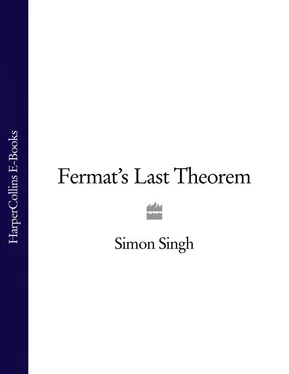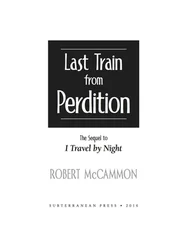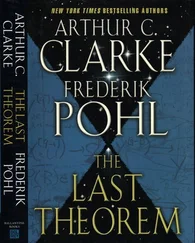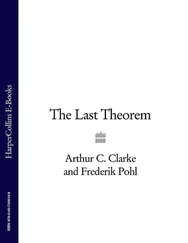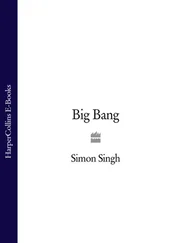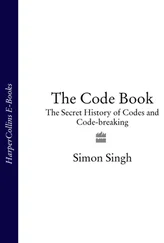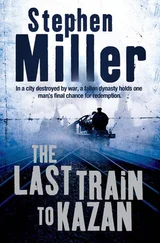SIMON SINGH
Fermat’s Last Theorem
THE STORY OF A RIDDLE THAT CONFOUNDED THE
WORLD’S GREATEST MINDS FOR 358 YEARS

Copyright Copyright Dedication Foreword Preface 1 - ‘I Think I’ll Stop Here’ 2 - The Riddler 3 - A Mathematical Disgrace 4 - Into Abstraction 5 - Proof by Contradiction 6 - The Secret Calculation 7 - A Slight Problem Epilogue - Grand Unified Mathematics Keep Reading Appendices Suggestions for Further Reading Index About the Author Also by the Author About the Publisher
William Collins
An imprint of HarperCollins Publishers Ltd.
1 London Bridge Street
London SE1 9GF
www.harpercollins.co.uk
First published in paperback by Fourth Estate in 2002 (reprinted 4 times)
First published in Great Britain in 1997 by Fourth Estate
Copyright © 1997 by Simon Singh
Foreword copyright © 1997 by John Lynch
Line illustrations by Jed Mugford
The right of Simon Singh to be identified as the author of this work has been asserted by him in accordance with the Copyright, Designs and Patents Act 1988
A catalogue record for this book is available from the British Library
All rights reserved under International and Pan-American Copyright Conventions. By payment of the required fees, you have been granted the non-exclusive, non-transferable right to access and read the text of this ebook on-screen. No part of this text may be reproduced, transmitted, downloaded, decompiled, reverse engineered, or stored in or introduced into any information storage and retrieval system, in any form or by any means, whether electronic or mechanical, now known or hereinafter invented, without the express written permission of HarperCollins ebooks
HarperCollins Publishers has made every reasonable effort to ensure that any picture content and written content in this ebook has been included or removed in accordance with the contractual and technological constraints in operation at the time of publication
Source ISBN: 9781841157917
Ebook Edition © NOVEMBER 2012 ISBN: 9780007381999
Version: 2017-08-14
Dedication CONTENTS Cover Title Page Copyright Dedication Foreword Preface 1 - ‘I Think I’ll Stop Here’ 2 - The Riddler 3 - A Mathematical Disgrace 4 - Into Abstraction 5 - Proof by Contradiction 6 - The Secret Calculation 7 - A Slight Problem Epilogue - Grand Unified Mathematics Keep Reading Appendices Suggestions for Further Reading Index About the Author Also by the Author About the Publisher
In memory
of
Pakhar Singh Birring
Cover
Title Page SIMON SINGH Fermat’s Last Theorem THE STORY OF A RIDDLE THAT CONFOUNDED THE WORLD’S GREATEST MINDS FOR 358 YEARS
Copyright
Dedication
Foreword
Preface
1 - ‘I Think I’ll Stop Here’
2 - The Riddler
3 - A Mathematical Disgrace
4 - Into Abstraction
5 - Proof by Contradiction
6 - The Secret Calculation
7 - A Slight Problem
Epilogue - Grand Unified Mathematics
Keep Reading
Appendices
Suggestions for Further Reading
Index
About the Author
Also by the Author
About the Publisher
We finally met across a room, not crowded, but large enough to hold the entire Mathematics Department at Princeton on their occasions of great celebration. On that particular afternoon, there were not so very many people around, but enough for me to be uncertain as to which one was Andrew Wiles. After a few moments I picked out a shy-looking man, listening to the conversation around him, sipping tea, and indulging in the ritual gathering of minds that mathematicians the world over engage in at around four o’clock in the afternoon. He simply guessed who I was.
It was the end of an extraordinary week. I had met some of the finest mathematicians alive, and begun to gain an insight into their world. But despite every attempt to pin down Andrew Wiles, to speak to him, and to convince him to take part in a BBC Horizon documentary film on his achievement, this was our first meeting. This was the man who had recently announced that he had found the holy grail of mathematics; the man who claimed he had proved Fermat’s Last Theorem. As we spoke, Wiles had a distracted and withdrawn air about him, and although he was polite and friendly, it was clear that he wished me as far away from him as possible. He explained very simply that he could not possibly focus on anything but his work, which was at a critical stage, but perhaps later, when the current pressures had been resolved, he would be pleased to take part. I knew, and he knew I knew, that he was facing the collapse of his life’s ambition, and that the holy grail he had held was now being revealed as no more than a rather beautiful, valuable, but straightforward drinking vessel. He had found a flaw in his heralded proof.
The story of Fermat’s Last Theorem is unique. By the time I first met Andrew Wiles, I had come to realise that it is truly one of the greatest stories in the sphere of scientific or academic endeavour. I had seen the headlines in the summer of 1993, when the proof had put maths on the front pages of national newspapers around the world. At that time I had only a vague recollection of what the Last Theorem was, but saw that it was obviously something very special, and something that had the smell of a Horizon film to it. I spent the next weeks talking to many mathematicians: those closely involved in the story, or close to Andrew, and those who simply shared the thrill of witnessing a great moment in their field. All generously shared their insights into mathematical history, and patiently talked me through what little understanding I could achieve of the concepts involved. Rapidly it became clear that this was subject matter that perhaps only half a dozen people in the world could fully grasp. For a while I wondered if I was insane to attempt to make a film. But from those mathematicians I also learned of the rich history, and the deeper significance of Fermat to mathematics and its practitioners, and that, I realized, was where the real story lay.
I learned of the ancient Greek origins of the problem, and that Fermat’s Last Theorem was the Himalayan peak of number theory. I was introduced to the aesthetic beauty of maths, and I began to appreciate what it is to describe mathematics as the language of nature. Through Wiles’s contemporaries I grasped the herculean nature of his work in pulling together all the most recent techniques of number theory to apply to his proof. From his friends in Princeton I heard of the intricate progress of Andrew’s years of isolated study. I built up an extraordinary picture around Andrew Wiles, and the puzzle that dominated his life, but I seemed destined never to meet the man himself.
Although the maths involved in Wiles’s proof is some of the toughest in the world, I found that the beauty of Fermat’s Last Theorem lies in the fact that the problem itself is supremely simple to understand. It is a puzzle that is stated in terms familiar to every schoolchild. Pierre de Fermat was a man in the Renaissance tradition, who was at the centre of the rediscovery of ancient Greek knowledge, but he asked a question that the Greeks would not have thought to ask, and in so doing produced what became the hardest problem on earth for others to solve. Tantalisingly, he left a note for posterity suggesting that he had an answer, but not what it was. That was the beginning of the chase that lasted three centuries.
Читать дальше
